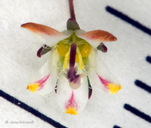Postscript (4/26/19): 1) The transparent rod-like appendages (which I usually call ''digitate processes'', since they're palmately arranged and are actually attached to the apices of short 'true appendages' at the bases of the two lower filaments) are now hypothesized to attract pollinators by simulating fully-charged nectaries with their glisten.
2) Note that the lower two photos in the collage appear there 'upside-down'. That is, the flowers in this species are ''inverted'' (or ''resupinate'')...so when properly oriented the 2-lobed lip of the corolla is 'on top' and the 3-lobed lip is 'on the bottom'.
3) Reference images by Nancy Morin for the two varieties of N. tenuis appear at this link. There can be subtleties in placing plants to variety, since there are often intermediate forms in the spectrum of variation between the extremes of N. t. var. tenuis and N. t. var. aliformis. Though somewhat intermediate, I'd place the plants here as N. t. var. tenuis due to the relatively mildly-zygomorphic corolla shape; the relatively wide & only slightly-curved frontal aspect of the upper two lobes; and the basally white and red-tipped coloration of those upper lobe. As I understand it, N. t. var. aliformis is characterized by a more strongly-zygomorphic corolla shape; with the two upper corolla lobes being significantly narrower (almost linear), more falcate, and more uniformly red throughout. For examples from the Death Valley region, see here and here.
